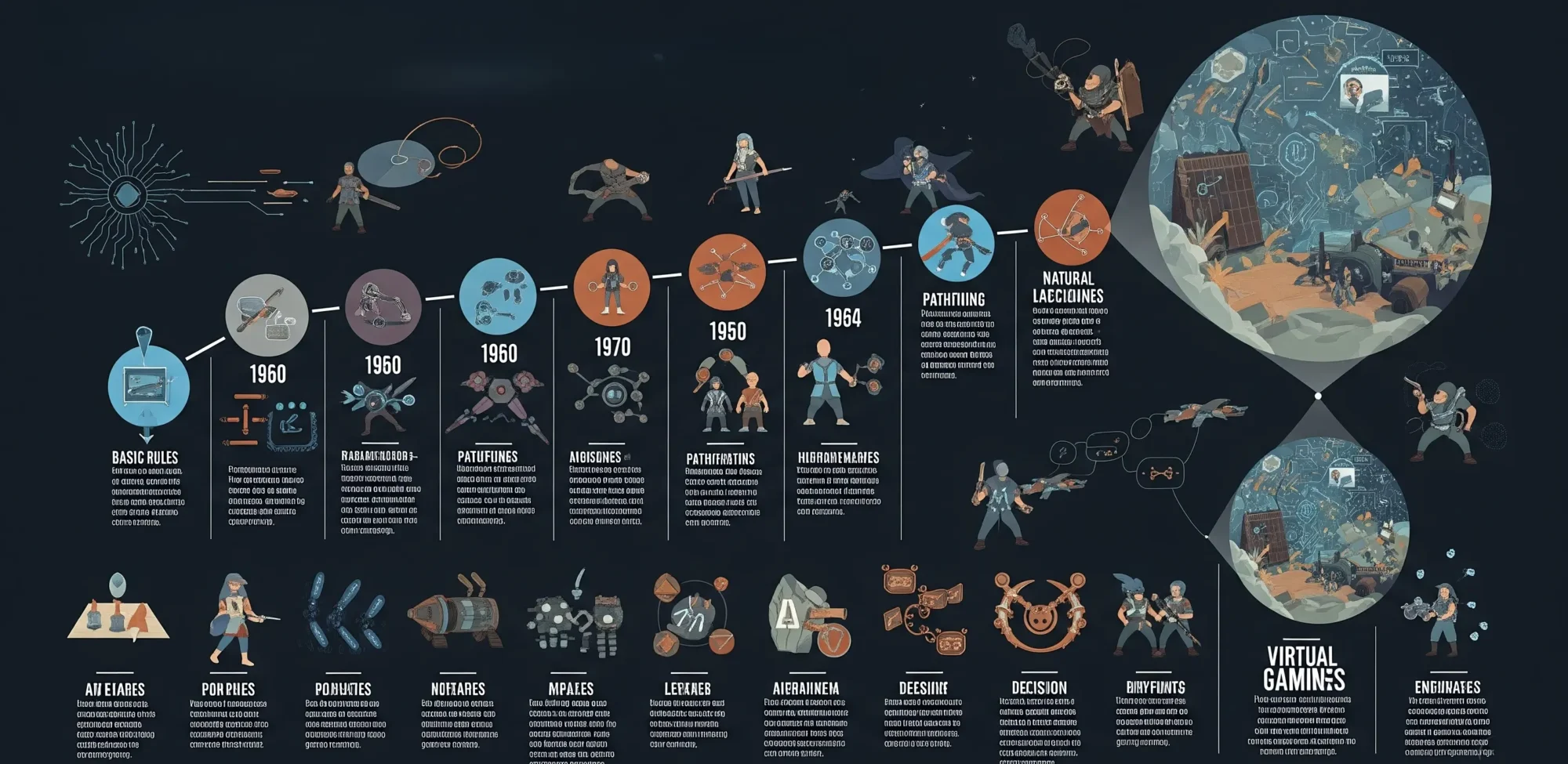
The Ghost in the Machine: How AI in Gaming Evolved from Simple Rules to Entire Universes
We have all felt that moment of awe in a video game. For instance, it’s the panic when a creature in a horror game seems to hear your every breath. It’s the surprise when a squad of enemy soldiers works together to flank you with chilling efficiency. Moreover, it’s the connection you feel when a character in a vast open world remembers a choice you made hours ago. This feeling of a living, thinking world is the magic of Artificial Intelligence. The steady evolution of AI in gaming is one of the most important, yet often overlooked, stories in the history of interactive entertainment.
This intelligence is not a simple trick. Instead, it is the result of over seventy years of brilliant design and technical innovation. The journey of AI in gaming starts in university labs. It leads to the incredibly complex and responsive virtual worlds we explore today. Understanding this history is key. For example, it shows us how developers use code to build compelling challenges, tell unforgettable stories, and create meaningful relationships with players. This article will explore that full journey. We will cover the history of how this technology evolved. In addition, we will also answer a crucial question: Why is AI so absolutely essential for creating the games we love? The story of AI in gaming is about solving creative problems to make games more immersive, personal, and vast than we ever thought possible.
The Dawn of Digital Thought: AI in the Lab (1950s-1960s)
Long before the glow of arcade cabinets, the first sparks of game AI were lit in the quiet halls of academia. In the 1950s and 60s, pioneering computer scientists used games as a testing ground. Their goal was not to create entertainment for the masses. Instead, they were teaching machines how to “think” and solve logical problems. Games like chess and checkers were perfect for this purpose. These games are complex systems with clearly defined rules. As a result, they were ideal environments for testing computational logic.
One of the very first examples was a program for tic-tac-toe called OXO. A.S. Douglas created it at the University of Cambridge in 1952. While the game itself was simple, OXO proved that a machine could follow rules. It also proved it could be a competent opponent for a human player. This was a foundational concept for game AI. Other pioneers, such as the famous codebreaker Alan Turing, also wrote theories for chess-playing programs. Subsequently, they laid the philosophical groundwork for the decades of innovation that would follow.
The most significant creation of this era was Arthur Samuel’s checkers program. Developed throughout the 1950s, this program had an amazing and revolutionary new ability: it could learn. Samuel’s program played thousands of games against itself. With each game, it stored data on which moves led to a higher probability of winning. It then used this information to improve its own strategy over time. In short, this was a brilliant and very early example of machine learning. The program eventually learned to play checkers better than Arthur Samuel himself. It clearly demonstrated that an artificial intelligence in game systems could improve through experience. This core idea was decades ahead of its time. These early academic projects were the true ancestors of every thinking enemy and helpful companion in modern video games.
The Arcade Revolution: The Illusion of Intelligence (1970s-1980s)
The 1970s and 80s brought video games out of the lab and into the public eye with the explosion of the arcade. This era was defined by severe hardware limitations. Developers had tiny amounts of memory and very slow processors. Therefore, creating believable AI under these conditions required immense creativity. They had to create the illusion of intelligence with simple but clever tricks. This focus on smart, efficient design was the hallmark of early AI in game creation.
A great example is the classic game Space Invaders (1978). The iconic alien enemies march back and forth, descending down the screen. They move as a single, unified block of sprites. There is no complex individual logic for each alien. However, the game’s hardware had an interesting quirk. As the player destroyed more aliens, there were fewer objects on screen for the processor to manage. This freed up resources and caused the remaining aliens to move faster. In fact, this technical limitation brilliantly created an escalating sense of panic and difficulty. It was a perfect example of effective AI emerging from simple design.
The true masterpiece of this era’s AI design was Pac-Man (1980). The four ghosts that hunt Pac-Man through the maze feel like a coordinated team. In reality, they are all following very simple, individual rules. This created a level of strategic depth never before seen in an arcade game. This was also a landmark moment for AI in gaming.
Each ghost uses a unique targeting method, which gives it a distinct “personality.” This system is a classic example of a Finite State Machine (FSM), where a character switches between a few defined states or behaviors.
- Blinky (Red): The simplest ghost. He is the aggressor, and his only goal is to target the exact tile Pac-Man is currently on.
- Pinky (Pink): The ambusher. Pinky tries to cut the player off by targeting the space four tiles in front of Pac-Man.
- Inky (Cyan): The wild card. Inky’s targeting is the most complex, as it depends on the positions of both Pac-Man and Blinky. This makes his movements much harder to predict.
- Clyde (Orange): The coward. Clyde targets Pac-Man directly, but when he gets too close, his programming makes him retreat to his home corner.
These simple rules combine to create incredibly complex and engaging gameplay. The player feels hunted from all sides. In addition, learning these simple patterns is the key to mastering the game. Pac-Man proved that powerful hardware was not needed to create a compelling AI in game experience.
The 3D Leap: A New Dimension of Challenge (1990s-2000s)
The 1990s marked a seismic shift in the industry: the move from 2D sprites to 3D polygons. This new dimension added incredible visual depth. However, it created enormous new problems for AI game development. An enemy AI no longer just moved on a flat plane. It now had to navigate a complex world with stairs, bridges, obstacles, and different elevations. The simple techniques of the past were no longer enough.
The Navigation Problem
The first major hurdle was pathfinding. How does an AI character know how to get from one room to another in a large, 3D level? How does it avoid getting stuck on a crate or falling off a ledge? The solution came in the form of the A* (pronounced “A-Star”) pathfinding algorithm. A* became the gold standard for video game navigation. It works by breaking a level down into a grid of nodes. Then, it calculates the most efficient path between any two points. This algorithm allowed characters to intelligently navigate complex maps. Consequently, it finally made believable movement in 3D worlds possible.
The Tactical Revolution
With movement solved, developers turned to making enemies act smarter. The true revolution arrived in 1998 with Valve’s masterpiece, Half-Life. The AI controlling the human soldiers in the game was unlike anything players had seen before. They didn’t just charge mindlessly at the player; they used squad tactics. This was a landmark achievement for artificial intelligence for games. Soldiers in Half-Life would communicate. For example, one might lay down suppressing fire while another flanked the player. They would strategically toss grenades to flush players out of hiding. They even showed a sense of self-preservation by retreating when wounded. This created dynamic combat encounters that felt more like a tactical puzzle than a simple shooting gallery.
A few years later, F.E.A.R. (2005) took this even further with a system called Goal-Oriented Action Planning (GOAP). Instead of following a rigid script, a GOAP AI is given a high-level goal, like “eliminate the player.” It then has a library of possible actions (shoot, take cover, throw grenade, knock over table). The AI can then dynamically create a unique plan by stringing these actions together based on the live situation. This made the AI in F.E.A.R. feel incredibly intelligent and unpredictable.

More Than an Enemy: The True Impact of AI in Gaming
The history of game AI is fascinating, but it only tells half the story. To truly understand the importance of AI in gaming, we have to ask why companies invest so heavily in it. The answer is simple. Specifically, AI can do things that are impossible for human developers to do, especially at the scale of modern games. This section explores the powerful impact of AI in gaming.
Building Impossible Worlds at Scale
Modern open-world games feature unimaginably vast landscapes. For example, a game like No Man’s Sky contains over 18 quintillion unique planets. A team of human artists, no matter how large, could never manually design and build a universe of that size. It is physically impossible. This is where Procedural Content Generation (PCG) comes in. PCG is an application of artificial intelligence for games that uses algorithms to create game content on the fly. It can generate entire planets, realistic forests, unique creatures, and endless quests. As a result, this allows developers to create games with a scope and scale that would be unthinkable otherwise. It provides near-infinite replayability and a true sense of exploration for the player.
Crafting a Personal Experience for Every Player
A human game designer cannot watch millions of people play their game. Likewise, they cannot personally tailor the experience for each one. But an AI can. This is one of the most exciting areas of modern AI in gaming. A great example is the “AI Director” from Valve’s Left 4 Dead. The Director is an AI system that constantly monitors the players’ performance, stress levels, and location. Based on this data, it dynamically adjusts the game’s pacing. If a team is doing well, for instance, it might spawn a huge horde of zombies to create a frantic climax. If the team is struggling, it might provide more health kits and a moment of quiet. This ensures the game is always challenging but rarely unfair. Ultimately, it creates a perfect, personalized experience in every single playthrough.
The Power of Emergent Narratives
The Nemesis System from Middle-earth: Shadow of Mordor is another landmark example. This system creates unique Orc enemies. They have their own names, personalities, strengths, and weaknesses. Crucially, these Orcs have memories. An Orc who defeats you will get promoted. He will also grow stronger. He might even taunt you about your last encounter when you meet again. This creates powerful, emergent narratives. It also forges personal rivalries that are completely unique to each player. This is a level of personalization that traditional, pre-scripted stories simply cannot match. This is a powerful use of AI in gaming.
Making Better Games, Faster and Cheaper
Game development is an incredibly expensive and time-consuming process. The budget for a major AAA title can exceed hundreds of millions of dollars. Therefore, companies are constantly looking for ways to improve efficiency. AI game development tools are a huge part of the solution. One of the most time-consuming parts of development is testing. A complex open-world game has a near-infinite number of potential bugs and glitches. Manually testing every possibility is impossible. Today, developers use AI bots that can play a game 24/7. These bots can explore the world, test every weapon, and try every combination of actions. In short, they find bugs far more quickly and thoroughly than a human QA team ever could.
AI is also being used to assist in the creative process. For example, AI tools can now help generate realistic environmental textures. They can create fluid character animations. They can even write first drafts for simple dialogue or item descriptions. This doesn’t replace human creativity. Instead, it automates repetitive tasks. This then frees up talented developers to focus on the high-level design and artistic choices that make a game great. The smart use of AI in gaming makes the whole process more efficient.
The Next Frontier: Learning, Adapting, and Creating
For most of its history, game AI has been a sophisticated puppet show. The behaviors are pre-programmed by developers. However, we are now entering the era of Machine Learning (ML). This is the next great frontier for AI Games. An ML-based AI can learn and improve on its own. It can do this without being explicitly programmed for every scenario.
The most famous example of this is DeepMind’s AlphaStar. This AI was trained to play the incredibly complex strategy game StarCraft II. Through a process called reinforcement learning, AlphaStar played the equivalent of 200 years of the game against itself. It eventually became so good that it defeated one of the world’s top professional players. In fact, it used unique strategies that no human had ever seen before.
This technology is already finding its way into commercial AI Games. It’s used to improve player matchmaking in online games. It helps to create more human-like bots. It also powers more believable character animations. The future possibilities are staggering. For example, imagine enemies that learn your specific tactics and adapt to counter you. Imagine characters you can have full, unscripted conversations with. This is the future that machine learning and better AI in gaming promise.
Conclusion
The evolution of AI in gaming is a remarkable journey of creativity and technical genius. It has grown from simple, predictable patterns into complex systems that can build entire universes and tell personal stories. We’ve seen how AI progressed from the simple FSMs of Pac-Man to the tactical brilliance of Half-Life and the emergent narratives of the Nemesis System.
More importantly, we’ve seen why this technology is so crucial. AI is the engine that allows for the scale, personalization, and efficiency that define modern gaming. For example, it creates experiences that are simply beyond the scope of manual human effort. As we look to the future, the continued advancement of AI in gaming, especially with machine learning, will undoubtedly lead to even more immersive, intelligent, and unforgettable worlds. The ghost in the machine is no longer just following a script; in fact, it’s starting to think for itself.
References:
- Samuel, A. L. (1959). Some Studies in Machine Learning Using the Game of Checkers. IBM Journal of Research and Development.
- Yannakakis, G. N., & Togelius, J. (2018). Artificial Intelligence and Games. Springer.
- Orkin, J. (2006). Three States and a Plan: The A.I. of F.E.A.R. Game Developers Conference (GDC) 2006.
- DeepMind (2019). AlphaStar: Grandmaster level in StarCraft II using multi-agent reinforcement learning. DeepMind Blog.
- Gamasutra (Game Developer) & IGN Archives: For historical game analyses and developer interviews.

